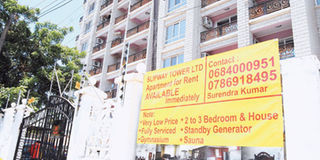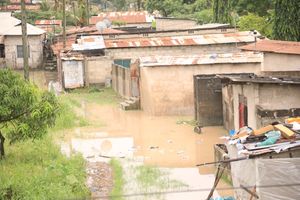Spiralling demand makes Dar rents the highest in East Africa

> A banner display available space for rent at slipway Tower along Chole Road at Maski in Dar es Salaam.
What you need to know:
It is estimated that Tanzania runs a housing deficit of three million units valued at $180 billion by the end of 2007, while the current annual demand for houses in urban areas is 200,000 units estimated to cost $12 billion, according to data from National Housing Corporation (NHC).
Despite the increasing number of tall buildings in the city, the supply of housing is yet to match the rising demand, a move that has kept rents higher than those of commercial capitals of Kenya and Uganda.
It is estimated that Tanzania runs a housing deficit of three million units valued at $180 billion by the end of 2007, while the current annual demand for houses in urban areas is 200,000 units estimated to cost $12 billion, according to data from National Housing Corporation (NHC).
Yet, only about 15,000 units can be supplied per year.
The Real Estate stakeholders propose the shift from the traditional expensive housing construction which normally targets high-income earners to development of low-cost housing units to cover more Tanzanians and probably that could improve the housing supply in the country.
Limited capital for developers and too many bureaucratic procedures for acquiring construction permits or registering property are cited as the main hurdles affecting the supply side while rural-urban movement and uneven development of the urban centres on the other hand are pushing up the demand.
For instance, the World Bank’s Doing Business Report 2015 ranks Tanzania on position 169 out of the 189 economies measured in the survey. In short, according to the World Bank, one needs to go through an average of 18 procedures that consume an average of 205 days in Tanzania to finally get a construction permit.
On the contrary, the same takes 10 procedures and a total of 77 days in Rwanda while in Burundi, one needs just 14 procedures and an average of 99 days to get a construction permit. Similarly, real estate developers in Kenya undergo an average of eight procedures within a maximum of 125 days while the same takes an average of 15 days and a total of 154 days in Uganda.
A 2015 Cost of Living Index study by Numbeo – the world’s largest database of user contributed data about cities and countries worldwide – puts Dar es Salaam on position one in terms of the expensiveness of rental costs in East Africa, outclassing Kenya’s Nairobi which is home to the highest number of workers for international organisations in East Africa.
The local real estate industry is driven by market forces of demand and supply and the government is now working on the possible regulatory authority.
Demand and supply
“There is limited capital for financing property development and as a result developers focus much on houses for high-income earners because that is where they are sure to recover their cost,” says Maximillian Matala, chief executive officer of Mutual Developers Ltd.
He says developers are required to contribute between 30 per cent and 60 per cent of the project they want to pursue. That means, if a project costs Sh10 billion, a developer needs to have in hand at least Sh3 billion (30 per cent) to qualify for the mortgage financing in a bank.
Whenever they get the mortgage, the developers repay the loan in very high interest rates of up to 26 per cent per annum while they also incur extra cost in the process of development, according to Mr Matala.
“That is a lot of money for developers other than pension funds which have heavy muscles in the industry,” he says.
“When we build houses, normally there are no basic infrastructure like roads, water and electricity. So, to make our projects accessible and marketable, we are always forced to develop the infrastructure at our own cost. It really increases costs to developers,” he says.
He says the developers should now focus on low-cost housing system for low income earners where they will avoid using expensive cement blocks.
The acting chief executive officer of Commercial Bank of Africa (CBA) Tanzania Mr Julius Mcharo says Tanzania’s mortgage is still a new field with a few developers and requires heavy capital amid risks.
CBA was a pioneer of mortgage in Tanzania when it came up with a 15-year mortgage in 2007 after a long time of almost inactive mortgage since the defunct Tanzania Housing Bank (THB).
He says the three million unit gap would not have been filled even if all banks in Tanzania lent in mortgage.
“The demand is so high while the supply of housing /mortgage is extremely low. Value Added Tax (VAT) and capital gains on the transfers when buying houses is also causing lots of problems and high cost to both buyers and sellers of mortgage,” he says.
According to him, the cost of mortgage is still high with interest rates ranging from 16 per cent to 25 per cent per annum, which could be another deterrent factor.
Tanzania is also reported to have too many bureaucratic procedures when issuing construction permits and registering properties.
The procedures affect the process and affect the property supply.
According to Doing Business 2015 report produced by the World Bank, Tanzania’s ranking in dealing with construction permits deteriorated to 169 from 166 in 2014 out of the 189 economies assessed.
The developer is supposed to go through some 18 procedures before obtaining the permit which completes in 205 days.
Kenya ranks 95 with only eight procedures which are sorted out in 125 days while Uganda ranks 166 for having 15 procedures in 154 days.
Tanzania also registers property in 67 days through eight procedures while Kenya does it in 72 days by going through nine steps. Uganda registers in 43 days under 11 steps, according to the report.
Apart from the delays, Tanzania’s current land laws restrict foreign ownership and therefore hamper potential capital for investment from foreigners, and thereby restrict supply with a consequent impact on housing.
“The supply is low due to the fact that the ratio of the number of people migrating to urban parts of the country is higher than the number of residential buildings and houses being built,” says Mustafa Suleimanji, managing director of the real estate online marketing place Lamudi for Tanzania, Zambia, Zimbabwe and Mozambique.
Although he cites the deficit, Mr Suleimanji warns that the current speed may put the market in danger in the long run.
“The Tanzania real estate market has unlimited potentials to grow vastly, however, the speed of this growth can be dangerous and cause the market to crash significantly. Property owners need to control their rental rates, and the government must invoke rental caps,” he says.
Rents are high
Some areas of Dar es Salaam are more expensive than the others due to what industry experts term as a result of traffic / infrastructure problems leading to everybody wanting to be close to the city and thereby distorting rents in particular areas.
The housing industry is also subject to value added tax (VAT) which adds more cost to the consumers, the experts say.
According to Numbeo, a Dar es Salaam resident pays the largest chunk of his/her earnings on house rents than on any other basic commodity that a human being must get to survive.
At least 34.1 per cent of earnings are spent on rents – leaving the remaining 65.9 per cent to cater for other needs including markets, clothing and shoes, transportation, restaurant costs, sports and leisure as well as paying for utilities like water and electricity bills.
On the contrary, for residents of Nairobi and Kampala, rental costs account for 23.7 and 13 per cent respectively of his/her monthly bill – leaving them with enough cash to cater for other basic needs.
In Dar es Salaam, according to Numbeo, one needs an average of $826.38 (about Sh1.446 million) to access a single bedroom in an apartment in the city centre.
The same costs an average of Ksh41,666.67 (about Sh791,666.73) and Ush661,875 (about Sh410,362.5) for Nairobi and Kampala respectively.
A Dar es Salaam resident - looking for a single-bedroom space in an apartment that is located outside the city centre - should be ready to pay an average of $555.37 (about Sh971,897.5) as monthly rental costs. In Nairobi and in Kampala, a similar space in a similar location goes for an average of Ksh19,777.78 (about Sh375,777) and Ush706,666.67 (about Sh438,133) respectively.
Similarly, for a three-bedroom space in an apartment located in the city centre, a Dar es Salaam resident will pay an average of $1,703.39 (about Sh3 million) while the same costs an average of Ksh91,273.61 (about Sh1.734 million) and Ush1,433,333.33 (about Sh888,667) in Nairobi and Kampala respectively.
If a similar space located outside the city centre, Numbeo puts the average costs in Dar es Salaam at $1,412.44 (about Sh2.5 million) while in Nairobi and Kampala, the same costs an average of Ksh62,940.28 (about Sh1.196 million) and Ush825,000 (about Sh511,500) per month respectively.




